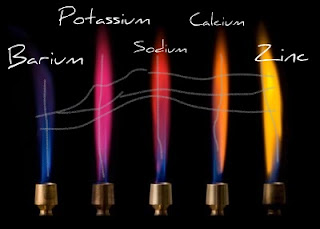Chemical formula shows the kind and number of atoms present in molecules or ionic compounds. Knowing the formula of a compound, you can determine the number of atoms and kinds of atoms present in a compound. For example, the formula of water, H
2O, will give you an information that there are 2 atoms of hydrogen and only one atom of oxygen, meaning the ratio of the elements also is shown in chemical formula.
Chemical formula can be molecular formula and empirical formula.
Molecular formula shows the exact number of atoms of each element in a molecule. Empirical formula shows the simplest ratio of elements in a compound or molecule.
Rules in Writing Chemical Formula
Compounds can be
binary compounds consisting only of 2 elements combined chemically, and
ternary compounds composed of 3 or more elements chemically combined. Example of binary compound is NaCl composed only of sodium and chlorine; while CaCO
3 is an example of ternary compound composed of calcium, carbon and oxygen elements,
A. Binary compounds
In writing the chemical formula of binary compounds you have to follow the rules below:
1. Identify the monoatomic cation and monoatomic anion that are present in a compound. Example, magnesium chloride, this compound is composed of magnesium ion and chloride ion or chlorine ion. Start by writing the symbol of cation (positive ion) and followed by the symbol of anion (negative ion).
Mg+2 Cl-1
2. In writing chemical formula, the total charge must be equal to zero. To balance the charges between the 2 ions above, the best way is to use the "criss cross process", which means that the oxidation number of the cation will be the subscript of the anion, and the oxidation number of the anion will be the subscript of the cation, disregarding the sign of the numbers.
Mg1+2 Cl2-1
Analyzing the charges, magnesium will have +2 charge and the chlorine will have -2, with a total charge equal to 0.
Finalizing the formula, we have:
MgCl2
B. Ternary Compounds
In ternary compound, it has the same rules as that of binary compound, only that parenthesis is used for polyatomic ions having 2 or more subscript.
1. Identify the monoatomic or polyatomic cations so as the anions. Also write the symbol or fomula of the cation followed by the anion. For example the compound Iron (III) sulfate, it is composed of iron having +3 oxidation number and sulfate ion (SO
4-2).
Fe+3 SO4-2
2. The same as that of the binary compound, the charge of the chemical formula of ternary compound must be equal to zero. So, to balance the charges the crisscross process also will be used. The oxidation of iron which is 3 will be the subscript of sulfate and the oxidation of sulfate will be the subscript of iron.
Fe2+3 SO4 3-2
Analyzing the charges, Fe will have a charge of +6 and sulfate will have -6, with a total charge of 0.
In writing chemical formula, polyatomic ion, although composed of 2 or more elements, just act as one in chemical formula writing, therefore the subscript 3 must not only belong to oxygen but also for sulfur, to do so parenthesis is used, as shown below:
Fe2(SO4)3
If the subscript of the polyatomic ion is equal to one, it is not written because absence of subscript means one. On the other hand, parenthesis also should not be written if the subscript is equal to 1.
Since writing chemical formulas involve balancing the charges between the cation and anion, once the charge is already equal, no subscript is added to both cation and anion. Like for example the compound calcium carbonate, composed of calcium ion and carbonate ion.
Ca+2 CO3-2
Since both have the same oxidation number, meaning the charge is already equal, the formula will be
CaCO3








